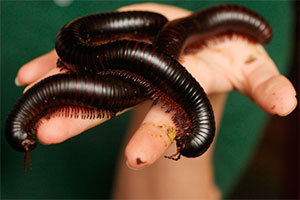
- LAST UPDATED: December 13, 2023
Are you scared every time you set your eye on a millipede? Sick of their suspicious coiling as if they are up to something? Here are the types of millipedes and the reasons for their fishy behavior.
Giant arthropods are harmless and nearly blind. Millipedes have a tough exterior exoskeleton and many tiny enjoined legs. They strongly resemble crustaceans and insects. These arthropods have elongated slim bodies made of numerous segments, covered by an exoskeleton. Each section holds two pairs of legs.
Most millipedes have glands along the body that produce toxic substances to keep off predators. They are mostly dark colored except for a few toxic ones with bright coloring.
Almost everybody has seen a millipede before. As common as they are though, many people have a hard time identifying one when they see it. That’s because there are a few different creatures that look similar and have a tendency to hang out in your garden or backyard.
Whether you’re trying to get rid of problematic millipedes or you just want to learn about the bugs in your backyard, this guide can help. Keep reading to learn about spotting millipedes, their habitat, what they eat and more.
Identification
Millipedes are arthropods that belong to the group Myriapoda. Unlike some other similar creatures, they have spiracles and they do not have direct copulatory organs, meaning they do not mate in a traditional manner.
Millipedes reproduce by depositing eggs in the soil, which will then hatch over time. Typically they reach sexual maturity, they do not reproduce this way, around the second year of their life. Many millipedes can live about four years if they do not become prey or get removed from a garden or backyard.
What Does a Millipede Look Like?
Millipedes are common in North America, and seeing one in your backyard or garden could be a likely occurrence depending on how much grass and dirt you have. For homes with large gardens or grassy areas, millipedes are almost sure to be found if you choose to look hard enough.
Millipedes are typically about two to four centimeters long with a dark brown appearance, though some may take on a more reddish tone in the sunlight. Certain types of millipedes may appear to be two-toned or striped, but this is generally only because of variations in color on the body of the millipede.
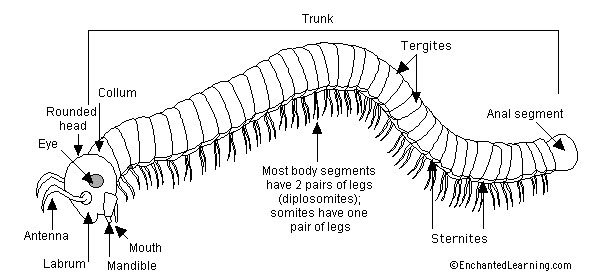
While you may not think they are the most attractive thing in your garden, millipedes should be easy to identify once you know what you’re looking for. In general, they are found in large groups, though they can be seen one or two at a time.
Are They Insects?
Millipedes are arthropods, though many people assume that they are insects. Because of their appearance, this is a pretty easy mistake to make.
The main difference is the way their bodies are made up:
- An insect has three main body segments.
- Millipedes have considerably more body segments. Insects also have three pairs of legs, which does not match up with the millipede.
Habitat
Millipedes definitely have a preferred habitat and a place they want to live in in your garden or backyard.
Moist habitats are where many people find millipedes:
- Under rocks, beneath beds of wet leaves, or near the roots of plants are typically where you will see millipedes.
- Piles of grass clippings, especially right after your lawn is mowed, may also make an ideal short-term home for millipedes.
In many cases, millipedes do not move far from home since they tend to find food in the same area. While it isn’t too unlikely that you’ll see a millipede in a grassy area, they’re much more common in areas with dirt, flowers, and plants.
You may also find millipedes under your home, beneath exterior structures like garden sheds, or beneath a dog house-type enclosure.
Common Millipede Species
The majority of millipedes in America are cylindrical shaped and drag their movement. Most of them live in wet forests and moist gardens or shaded bushes.
- Cylindroiulus Caeruleocinctus
This is a large kidney-shaped millipede (20 to 30 mm). It has a delicate blend of brown-black color with brass-like edges on the segments. It has no rear pointing on the telson. Mostly found near residential areas with leafy vegetation including small-forested areas and bushy compounds as well as parks.
Cylindroiulus Caeruleocinctus -
White legged Snake Millipede (Tachypodoiulus niger)
This millipede grows up to 25 mm. It has a banded appearance with pale brown segments and darker spots along the sides. The eye area has a black facade across eyes and a light tail end. It mostly hides in moist gardens and woodlands and gardens, rotting wood or leaf waste. Snake millipedes feed on decomposing leaves.
The tubular black body holds its contrasting white tiny legs. It has a pointed rear projection pointed away from the telson. Its black body and contrasting white legs (about 100 of them) make it possible to recognize the white-legged snake millipedes. It also has a protruding rear segment.
Millipedes feed on decaying matter such as algae and vegetation.This type of millipede mostly lives in woodlands, in gardens, and anywhere with rotting foliage, under rocks where it can hide. It eats dead plant matter and algae. It’s useful in the backyard as it returns decaying plant matter to the soil.
Tachypodoiulus niger - Striped Millipede (Ommatoiulus sabulosus)
This species is a cylindrical, plump, and brown millipede easily identified by the ginger stripes along its segmented body. This is one of the largest millipede species. It is mostly found in sandy areas during the day and it likes to hide under old logs and at the top of trees or internal walls.
Ommatoiulus sabulosus
Large Millipedes
The giant millipede belongs to the Spirostreptida order. Most of these creatures live in tropical as well as arid coastal areas of East Africa, along with the shorelines, in moist bushy areas, and are mostly seen during the rainy season. Large millipede grows up to approximately 12 inches in length. Most of them live up to five years old; they feed on decaying plant matter.
Giant African
Scientifically known as Archispirostreptus Gigas, 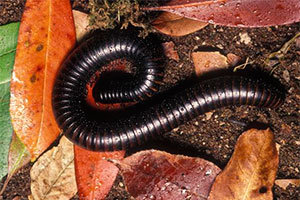
The giant millipede mostly dwells in East Africa, Mozambique, and the wetlands of South Africa.
The African arthropod is black and lives up to 7 years maximum. Giant millipedes get free grooming services from small mites in exchange for protection and free meals, providing a unique symbolic relationship between the two animals. Mites like to crawl on the millipedes’ exoskeleton and between their tiny legs.
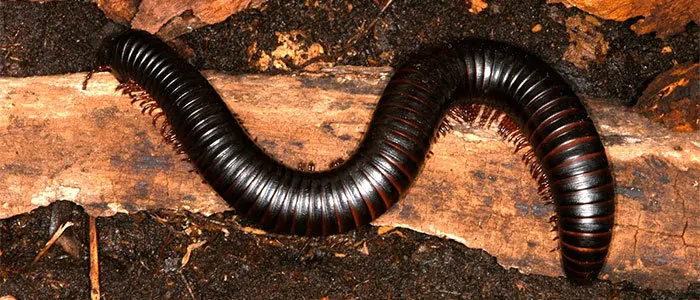
American Giant
Found in North America, the American giant millipede (Narceus americanus) grows up to 10 cm, and takes a cylindrical shape, unlike the regular-sized flat-shaped millipedes.
They are dark red-brown or black with a red line on the sides of each segment. They have two pairs of legs on the segments, rather than a pair on each segment. However, the first four parts hold a single pair of legs, and the subsequent abdominal segments have two pairs of legs. Like their African cousins, American Giant millipedes eat decaying plant matter.
Due to their size, American giant millipedes mostly live in forested areas in decaying logs and on wet forested leaf litter. They also roll up into a tight ball to evade predators or secrete poisonous liquids. They do not bite, and cannot crawl faster like their lethal biting cousins, the centipedes.
North American Millipedes overstay in rotting logs or underground soil and come to the surface in spring to mate.
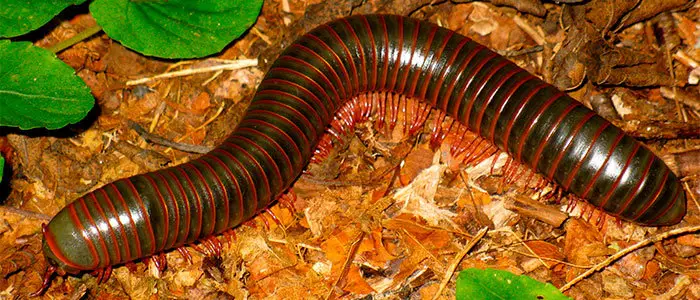
Order Polydesmida – Flat-Backed Millipedes
The Polydesmida class forms the largest type of millipedes, with nearly 3,500 species. The term Flat-Backed millipedes derive from the keels on each body segment. These millipedes vary in length ranging from 3mm-130mm. They have no eyes and contain small pairs of legs from the lower body sections.
Most of the larger poly-desmids change their body color to warn predators of their poisonous liquid secretions. Flat–backed millipedes are mostly found in rotting leaves, which also make up for most of their dietary needs.
Different Colors of Millipedes
Most North American millipedes come in diverse colors, depending on the geographical location. Desert millipedes have dark brown bodies; the dangerous ones don a bright orange or yellow/bright orange tan. Some have black stripes or red stripes on their sides.
In America, they come in many different colors and include a unique line of a few giant millipedes that dwell in the desert instead of the environment of the typical tropics.
Spread out across North Africa, millipedes come in an assortment of colors. The bright colored ones often glow at night to warn predators of the looming danger if approached.
- Brown/Black Millipedes
Mostly found in North America. They are docile, live in seclusion in decaying trees, bushes, and sometimes found in residential backyards.
- White/Red Millipedes
These brightly colored species have unusual anosmatic coloring that acts as a defensive mechanism to warn predators of the toxic substances released when touched.
House and Garden Millipedes

Humans should tolerate millipedes, when possible. If they invade your compound to warrant removal, you may use non-chemical methods.
The safest way to discourage millipedes off your yard is to:
- Regularly sweep decomposing leaves and leaf litter as often as you can.
- Remove soil borders from your outer wall building and trim unwanted vegetation and young shrubs around the fence.
- Declutter your yard and discard old boxes and logs lying around the compound.
- Reduce thatch in your garden to discourage millipedes by clearing out dead leaves during the early fall.
- Within your home, millipedes die naturally because of the dry environment. When you find a millipede in your house, gently push it with a broom, and toss it out. Millipedes don’t attack humans when confronted, but they coil into a hard ball, making it easier for you to move it without necessarily killing it. If you move it to a dry area, it will eventually die.
- Seal all the huge cracks behind baseboards where wet floors may attract millipedes as hideouts within your home.
- Place a dehumidifier to sufficiently dry the dumpy areas.
How Millipedes and Centipedes work as a Team to Improve Your Garden
Unlike the harmless millipedes, Centipedes are dangerous carnivorous arthropods. They paralyze their prey with two pointed appendages, which also act as limbs.
Millipedes and centipedes play essential functions that enhance the soil in your garden:
- In the soil food chain, both the millipedes and centipedes make up the first soil inhabitants and some of the most common earthly invertebrates.
- Their importance to the development of soil nutrients holds great significance to the stability of backyard lawns and gardens.
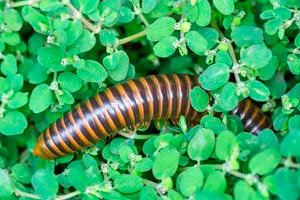
The cyanide-generating types of millipedes demonstrate their significance to the ecosystem. They form an essential part of humid ecosystems for their role in regurgitating decayed vegetation and cycling soil nutrients back into the ground. Diplopods influence direct decomposition by breaking leaf debris and indirectly moving microbial biomass.
To learn more about the difference between centipedes and millipedes, see this page.
Tropical Ecosystems Management
Soil experts who study the influence of millipedes from across different environments all agree on the importance of millipedes in soil chemistry and the overall ecological cycle. Depending on the arthropods density in a given area and the mass leaf ratio, the process of recycling and decomposing improves the affected regions.
Soil microbial significantly increases with millipede density in any given area. The type of ground foliage and the overall population of millipedes affect the soil pH extensively; because of the direct effect on decaying leaf litter and the overall quality of the foliage.

The exploration of soil value shows that various types of millipedes with the help of soil fungi earthly warms, and insects all contribute to rich soil formation. They help by breaking down foliage and soil debris in tropical areas. However, millipedes have a small or no direct effect on microbial biomass.
Management of millipedes and other insects in your property may prove as the best treatment for crawling millipedes. These arthropods feed on the decayed matter; they may die sooner, or else seek shelter under decaying wood near your foundation, or hide under rotting cabinets in your bathroom or kitchen areas. Reduction of dampness helps reduce millipede numbers exponentially.
Diet
A lot of people worry that millipedes in their garden will eat bugs that actually help with the soil or keep more problematic pests away, millipedes have a vegetarian diet. In fact, they may actually be able to improve the quality of your soil, helping your flowers and plants thrive year-round.
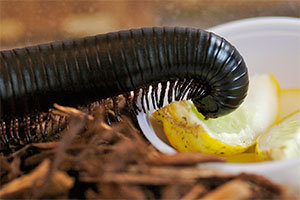
Millipedes may seem like a garden nuisance, but they are actually a part of the life cycle of soil, helping with decomposition and nutrient properties.
Are Millipedes Poisonous?
There exist different types of millipedes. The different species have very close similarities making it difficult for you to determine the exact type that you are handling. But what are millipedes?
Millipedes are worm-like arthropods that have well-rounded body segments and numerous jointed appendages. These creatures vary in length and color and love to infest dark and moist areas of your house. Are the millipedes poisonous?
All the types of millipedes known are not poisonous to human beings. However, they have defensive mechanisms to protect themselves from their enemies. Key among the methods they use is the production of irritating fluids. The fluids do not have severe effects on human beings except a few individuals who may experience allergic reactions.
 The millipedes release fluids containing several chemicals including hydrochloric acid, hydrogen cyanide, organic acids, phenol, cresols, benzoquinones and hydroquinone. It’s, therefore, imperative to avoid direct handling of the millipedes.
The millipedes release fluids containing several chemicals including hydrochloric acid, hydrogen cyanide, organic acids, phenol, cresols, benzoquinones and hydroquinone. It’s, therefore, imperative to avoid direct handling of the millipedes.House Millipede Bite
House millipedes are considered low-risk pests. They do not bite. However, the creatures’ segmented body and the numerous jointed appendages can be intimidating. This can cause a lot of discomfort among your family members.
Additionally, arthropods can cause severe skin irritations and other complications. This occurs when the threatened millipede produces and splashes a defensive fluid on the skin. People react differently to the attack depending on factors including the type of the millipede, the individual’s tolerance level, and the state of the immune system.
Individuals who experience allergic reactions are likely to manifest the following signs:
- Pain and Irritation. The fluid produced by the millipedes contains some acidic components which may cause excessive irritation on the skin. In most cases, the irritations are localized to the region affected.
- Redness. Redness is one of the commonest signs that manifest when the millipede splashes you with its defensive fluid. This shows that the body is alert to fight the alien substances.
- Inflammation. This results from allergic reactions where the body fights back to protect against infections.
- Skin Discoloration. This is a long-term effect of the interaction with the millipedes’ defensive fluid. It is primarily caused by the corrosion of the skin by the acidic elements of the fluid which leads to the progressive death of the skin cells.
- The pain of the Cornea. This is a serious symptom that may signify the splashing of the fluid into your eyes. Conjunctivitis will suffer from severe irritations and may progress into inflammation.
Although the fluid is not life-threatening, you should always be careful not to rattle the millipedes.
If the millipede has already splashed you with the irritating fluid, take the following steps immediately:
- Wash with plenty of water and soap. This should happen immediately after the splash. You should first splash the affected section with plenty of water and then add the soap to completely clean the section. If painful, you can carefully place an ice cube on the affected region to give you relief and a cooling effect.
- Use of Papain.
Papain can be very helpful in eliminating some of the irritants in the fluid. This happens through the enzymatic breakdown of the fluid. The breakdown eventually neutralizes the effects of the fluid leading to reduced irritations. However, the use of papain should never substitute the thorough cleaning of the region.
- Use of corticosteroid cream. This is applied only when there is a skin reaction. It helps in the prevention of bacterial and fungal infections of the skin.
Cover the area with a clean and fresh bandage. It is important that you don’t allow the exposure of your compromised skin to another form of irritants or pollutants. This is achieved through the use of a fresh bandage.
If the irritations become unbearable, it is advisable that you seek medical advice from your physician. This should always come after washing the affected region and keeping it dry. The doctor will examine you, and if he/she determines that it is an allergic reaction, an appropriate dosage of antihistamine will be administered.
If the eyes were affected, you should immediately seek medical attention. First, ensure that you thoroughly wash your face to dilute or entirely eliminate the fluid before rushing to the hospital.
Black and Yellow Millipedes
The black and the yellow millipedes are among the commonest species of arthropods. Like all the other millipedes, these species are not poisonous. They react to their threat by curling their bodies. When the threat becomes unbearable, these creatures evoke their glands to produce an irritating fluid. The major component of the fluid is hydrochloric acid which has the potential to burn and discolor your skin. The furthest that these species can spray the irritating liquid is 80 cm (Approximately 32 inches).
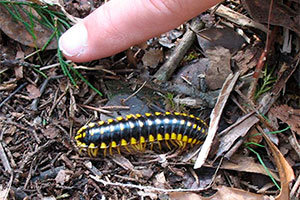
The millipedes are not harmful to human beings. However, the creatures can cause a lot of discomfort among your family members. This is especially a primary problem if you have children in your house. The anatomy of the arthropods can be blood-cuddling; they are characterized by large number of appendages and largely segmented bodies. As such, you should drive them away from the house.
Questions & Answers
Millipedes do not produce venomous substances.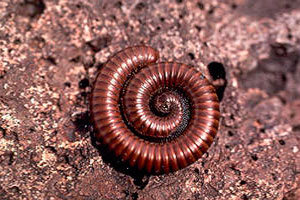
However, they should never be handled roughly as they can produce an irritating liquid as a defensive mechanism. Although the liquid can be highly irritating to the skin, it is not venomous.
Millipedes are not aggressive creatures. They are slow-moving, and they majorly feed on decomposing vegetative matter and other organic materials. The creatures do not bite even when threatened. Their primary defense mechanism is curling into a tight coil to protect their delicate legs inside the hard body exterior. They remain harmless unless severely provoked to produce an irritating liquid to splash to the enemy.
Millipedes are not dangerous creatures. They are harmless unless they are threatened. When the arthropods face any particular danger, they activate their innate defensive mechanisms. They have glands that produce special fluids that possess irritating effects.
The chemical fluid sprays can cause a lot of skin irritations and can lead to skin discoloration in the long run. It is vital to note that this is only a defensive mechanism used by the millipedes when they are in danger. As such, you should always avoid threatening the millipedes so roughly.
Also, you should always protect yourself from the fluid spray through:
- Avoid touching the millipedes with your bare hands. In as much as the creatures are largely harmless, always cover your hands when handling them. This ensures that you do not get sprayed with harmful fluid and that your safety is guaranteed.
- Avoid fluids in contact with your eye. Although the millipedes cannot splash the liquid past 30 cm, it is important to be cautious. Also, avoid touching your eyes immediately after handling the millipedes.
- Wash your hands thoroughly after handling millipedes. Handling millipedes may leave an unpleasant smell on your hands. Always make sure that you carefully clean your hands to entirely get rid of the odor. You can also use other solvents to remove the noxious fluid. You should, however, avoid the use of alcohol for cleaning.
The millipedes are not known to be vectors of any disease. This means that the presence of the millipedes in your house cannot cause illnesses to the members of your family.
Millipedes are not exactly high on the food chain, and in the average backyard, they are prey for several animals:
- In many cases, larger animals like badgers will go after full-grown millipedes with ease.
- Young millipedes are especially susceptible to being hunted by other animals. Large ants, ground beetles and even spiders can eat groups of young millipedes.
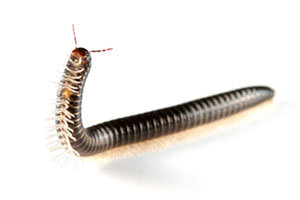
Unlike centipedes, they also do not sting or bite, so they aren’t going to cause any harm if you, your children, or your pets come into contact with them. While you might still want to wear gloves if you need to collect and move them, they aren’t going to bring any harm your way.
If you do need to move millipedes, collecting them along with soil that they are attracted to is your best bet. Typically, wherever you find the millipedes will be an area where the soil is right for them.
If you’re going to transplant them to your garden to improve the soil, try to take as much of the soil that they like there. Otherwise, they may leave your garden to try and find a better food source.
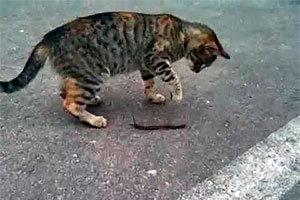
The cat behaves in a weird way and can:
- roll itself,
- run up and down,
- meow desperately.
Although this fades away with time, you can always spot the site of irritation and wash with plenty of water.
If the cat swallows the millipede, there is nothing much that happens.
However, in some rare instances, the cat may develop discomforts that reflect through:
- restlessness,
- inability to eat,
- vomiting.
This happens when the millipede produces the irritating liquid after being swallowed. The liquid can also irritate the throat, leading to the cat making an uncoordinated noise that may go on for some time. In most instances, this situation resolves after a short while.
When to call a veterinarian? In severe cases, it is always important to consult your veterinarian. This is when the situation is prolonged. The cat may show signs such as excessive vomiting, lack of appetite, and lethargy.
House Millipedes do not sting. The millipedes are naturally harmless creatures. They are among the safest arthropods.
Millipedes may seem like a nuisance to a lot of people, and while they aren’t necessarily pleasant viewing, they are not hurting your soil. The fact is that millipedes are an important part of creating long-term healthy soil in many places because they tend to eat decaying, dead matter.
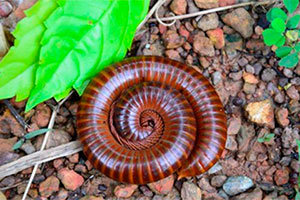
Many people are more familiar with centipedes than millipedes because of their unique colors and large size. This makes them much more likely fodder for nature television shows and photographs.
Unlike centipedes, though, millipedes do not bite, and they are not poisonous to animals or people. Instead, they thrive on a vegetarian diet that will actually benefit most homeowners.
Millipedes are attracted to an area because it makes for good habitat and is home to a potential food source. Typically, food sources include wet leaves and decaying organic matter.
Since millipedes like to live in dark, moist environments, beds of nutrient-rich soil used for planting are common backyard homes for them. They can also be found in plants or pots of dirt and areas around your home that are watered regularly since they prefer moisture.

A millipede can have anywhere from approximately 40 to 400 legs. Millipedes are also able to stay healthy and continue to move if some of their legs are damaged.
As millipedes get older, their number of legs may change over time!

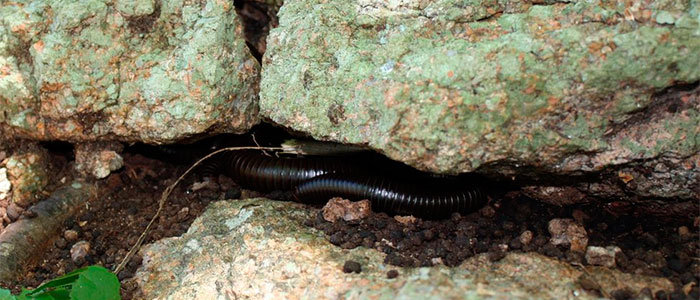

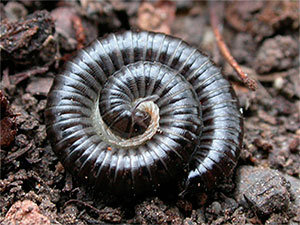 This millipede grows up to 25 mm. It has a banded appearance with pale brown segments and darker spots along the sides. The eye area has a black facade across eyes and a light tail end. It mostly hides in moist gardens and woodlands and gardens, rotting wood or leaf waste. Snake millipedes feed on decomposing leaves.
This millipede grows up to 25 mm. It has a banded appearance with pale brown segments and darker spots along the sides. The eye area has a black facade across eyes and a light tail end. It mostly hides in moist gardens and woodlands and gardens, rotting wood or leaf waste. Snake millipedes feed on decomposing leaves.

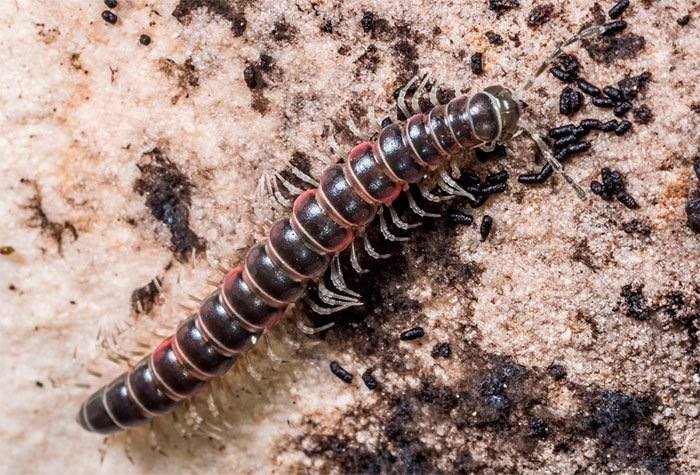
 Mostly found in North America. They are docile, live in seclusion in decaying trees, bushes, and sometimes found in residential backyards.
Mostly found in North America. They are docile, live in seclusion in decaying trees, bushes, and sometimes found in residential backyards.

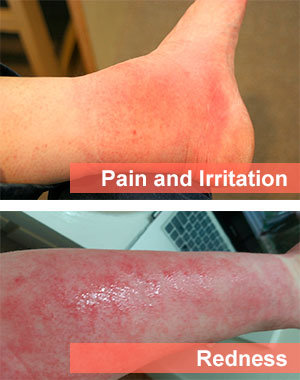
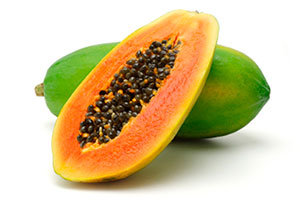 Papain can be very helpful in eliminating some of the irritants in the fluid. This happens through the enzymatic breakdown of the fluid. The breakdown eventually neutralizes the effects of the fluid leading to reduced irritations. However, the use of papain should never substitute the thorough cleaning of the region.
Papain can be very helpful in eliminating some of the irritants in the fluid. This happens through the enzymatic breakdown of the fluid. The breakdown eventually neutralizes the effects of the fluid leading to reduced irritations. However, the use of papain should never substitute the thorough cleaning of the region.